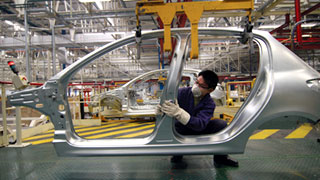ASIAN AUTOMOTIVE INDUSTRY
Emerging Fast
 |
| PSA Peugeot Citroën's July announcement of a new 150,000- annual- vehicle plant in Wuhan comes on top of a doubling of capacity to 300,000 vehicles by 2008 at its existing complex in Wuhan, pictured here. |
"I will say however that what does differ is putting up the buildings," he says. "It seems to move incredibly fast – there is a sense of entrepreneurialism in China that is unrivalled in the world. The Chinese [historically] were leaders as merchants. I do believe that that feeds into their approach to work and life and their overall approach toward their business."
He sees it at work in the gradual elimination of bureaucracy too, beginning with such mundane matters as airport arrival processing.
That same sense of entrepreneurialism lies at the root of intellectual property concerns on the part of multinationals with operations in the country. McNaughton says part of what Wescast does is design and engineer components in "black box" mode: "You're given some specs and details, and you have to design from there." He says that involves a lot of know- how relative to intellectual property, and it's all housed in Canada and Europe at this time.
"We're going to be assessing what is required in China as well as we move forward," he says. But he's also careful to point out that IP protection is a constant issue in any territory. Moving beyond concerns about government enforcement of IP law, a company has to be proactive in areas like employee retention and working with customers as well.
That kind of rigor is what site selection demands in China too, says McNaughton.
"Go back to the field, assess, then go back to the field again," he says. "In China, nothing is transparent. You have to triangulate a lot to make sure your data is in good shape. In North America and Europe, you have mature markets and systems. In China, it's all emerging."
One of the latest projects to emerge in Wuhan since Wescast's April announcement was the July announcement by PSA Peugeot Citroën, a Wescast customer in Hungary, that it would build a new plant with its Chinese partner, Dongfeng Motor Group Co., Ltd., that would produce 150,000 vehicles a year at capacity. That comes on top of a doubling of capacity at the company's existing plant in Wuhan, to 300,000 cars a year by 2008. This latest project will be accompanied by a capacity expansion at Dongfeng's mechanical components plant in Xiang Fang, Hubei.
Another sure indicator of growth to come: There are more than 23,000 miles (37,007 km.) of highway in the country now, traversed by about 20 million passenger cars – up from 6 million just six years ago. Those highway miles are projected to reach 53,000 (85,277 km.) by 2035, as the Chinese government aims to literally prepare the way for industrial development via its six- year- old "Go West" program. No wonder, then, that in July Japanese firm Ube Industries Ltd. announced a new $82- million synthetic tire rubber plant to be operated jointly with Taiwan- based Marubeni Corp. in Nantong City, Jiangsu Province.

